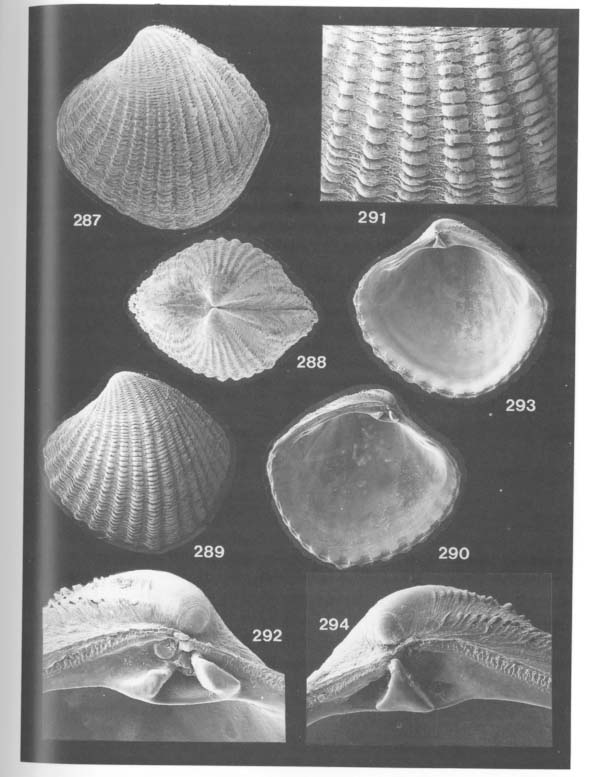Systematic Description
Carditella iejimensis sp. nov.
|
  |
1992. Carditella sp., Kase and Hayami, Jour. Moll. Studies, vol.58, p.448, listed.
1993. Carditella sp., Hayami and Kase, Univ. Mus. Univ. Tokyo, News, no.27, p.3, fig.8.
Type and material.— Holotype: RM19526a, a living specimen, from the bottom sediments of "Shodokutsu" of Ie Islet, Okinawa. Paratypes: RM19526 (living) from the type locality, RM19571 (living) from "Daidokutsu" of Ie Islet.
Diagnosis.— Small-sized cryptic species of Carditella, characterized by subquadrate outline, considerably developed resilium, clearly delimitted lunule and escutcheon, lucinoid teeth typical of the genus, and 16-20 granulated radial ribs, two of which are scaly and stronger than others in early dissoconch and delimit posterior area and escutcheon.
Description.— Shell very small, rarely exceeding 3.3 mm in length and height, subquadrate, translucent but light-brownish when alive, slightly longer than high, moderately thick, strongly inflated. Umbo prosogyrous, contiguous, located about two-fifths of shell length from anterior end. Antero-dorsal margin long, a little concave; postero-dorsal margin feebly convex, turning somewhat abruptly into posterior margin. Lunule and escutcheon wide, distinct, not ornamented. Surface covered with 16-20 (18 on average) radial ribs which appear granular owing to numerous strong commarginal lamellae; on early dissoconch two radials are scaly and more prominent than others, corresponding to small posterior and escutcheon carinae, though the difference in prominence becomes insignificant with growth. Marginal crenulations distinct. Ligament external but continuous to a developed resilium just behind beak. Hinge teeth typical of the genus, as formulated: AIII (3a) 3b PIII/AII 2 4b PII; 3a not clearly separated by valve margin, 3b triangular, very thick, 2 and 4b also stout, and lateral teeth lamellar and weak. Dorsal margin retains numerous denticles of provinculum. Pd I comparatively large, suborbicular, ranging 130-157 µm in maximum diameter; Pd II not discriminated.
Remarks.— Numerous living individuals were found on the sediment surface of a totally dark cave "Shodokutsu". The present species is somewhat similar to Carditella infans Smith, 1885, from the south of New Guinea in its small shell size, granulated radial ribs and persistent denticles along dorsal margin. Such granulated surface are also known in many described species of Carditella; the subquadrate shell and two stronger radial ribs defining the posterior area and escutcheon in the early dissoconch are so characteristic that none of them seems to be closely related to the present species. Some species of the genus Plenromeris Conrad, 1867, exhibit a similarly granulated surface, but its type-species, P. decemcostata Conrad, 1867, possesses the more obliquely elongated cardinal tooth 3 a.
Venericardia quadriangidata Nomura and Zinbo, 1934, from the Upper Pleistocene fore-reef sediments of Kikai Island, Kagoshima Prefecture, resembles the present species in the subquadrate outline, but the fossil species is characterized by much larger shell size and fewer radial costae than the present species.
Distribution.— This carditid is the most dominant molluscan species in the caves of Ie Islet, but no specimen has been found from any cave of Shimoji and Irabu Islets of Miyako Islands.